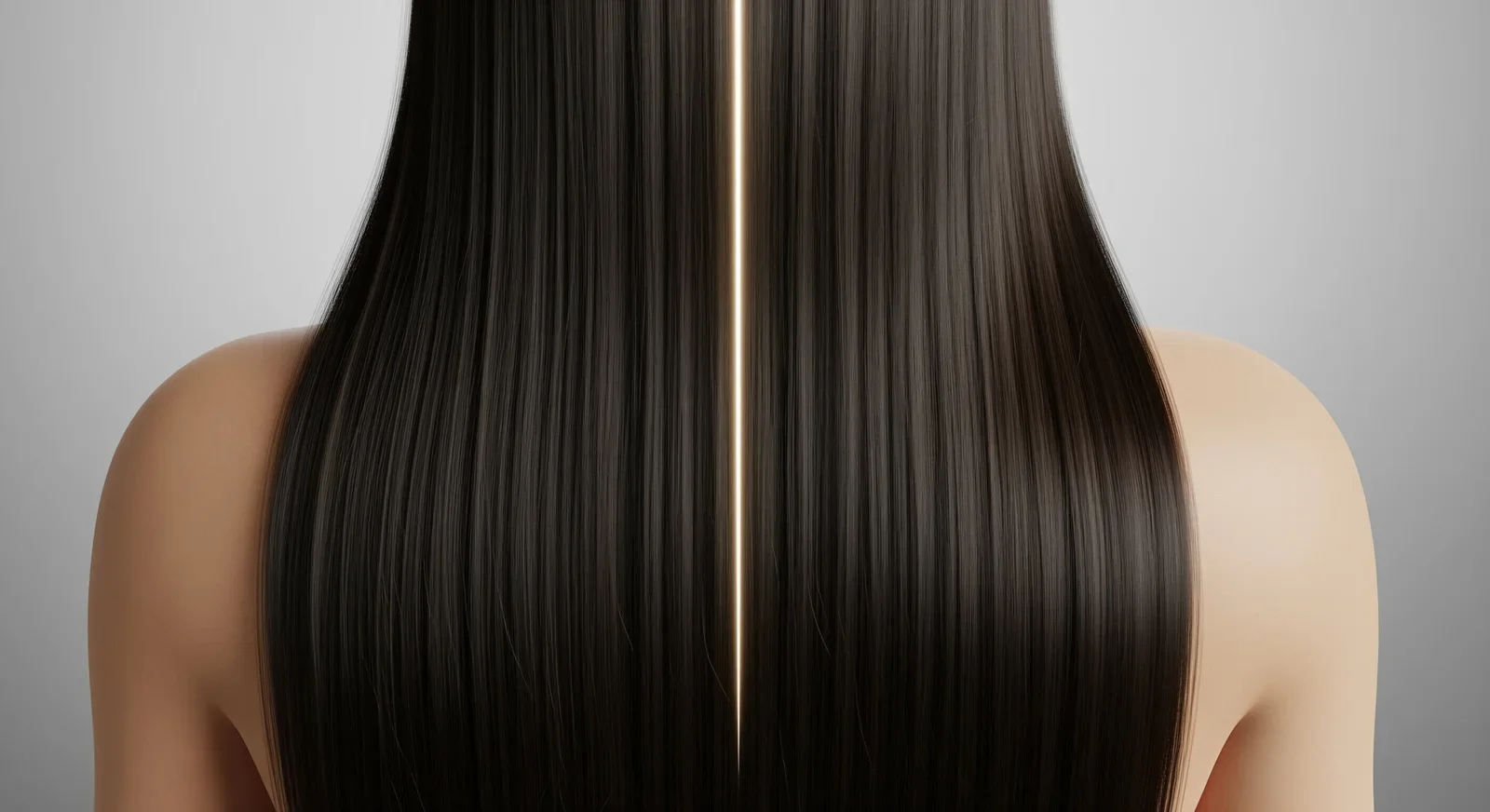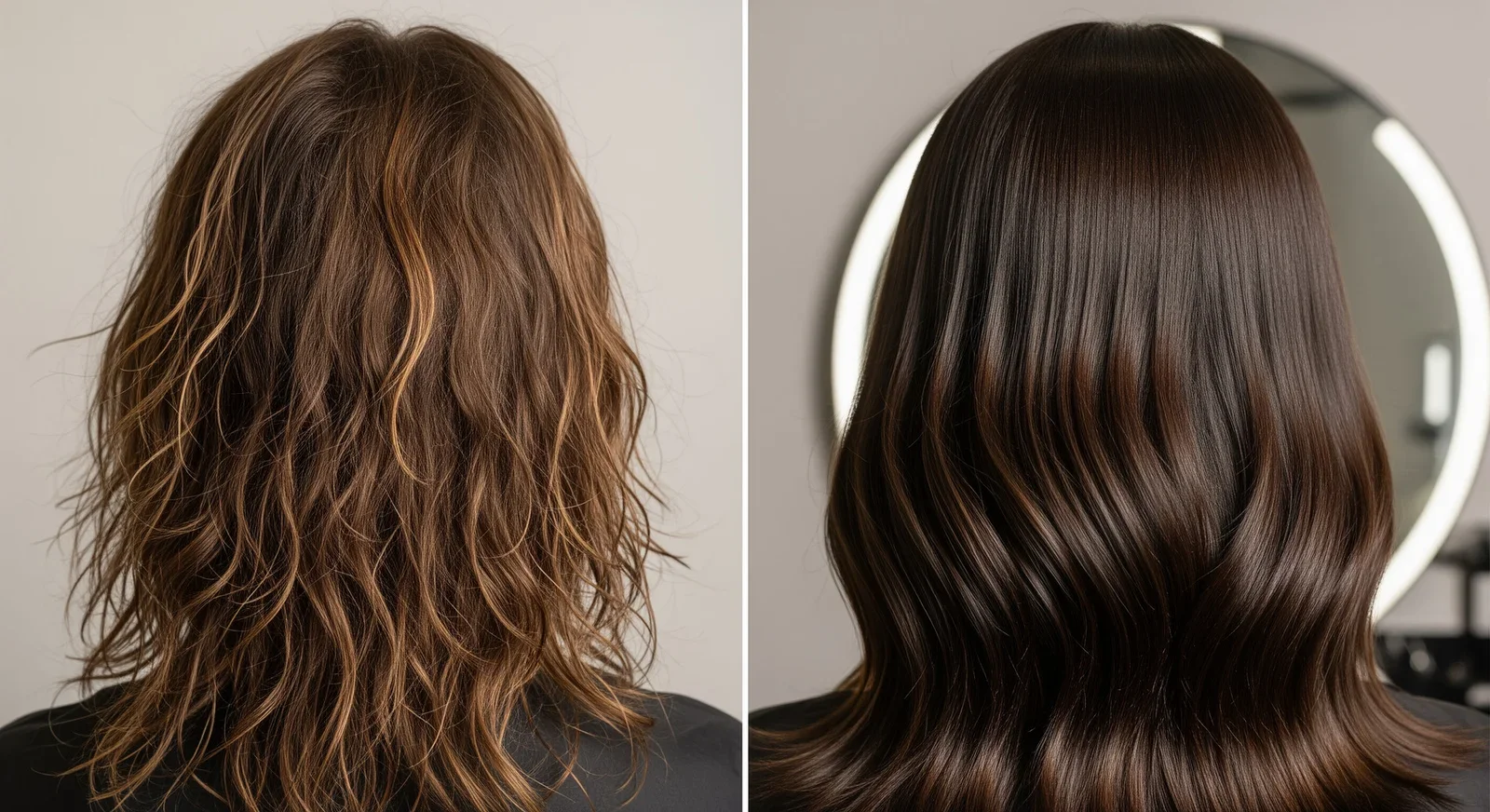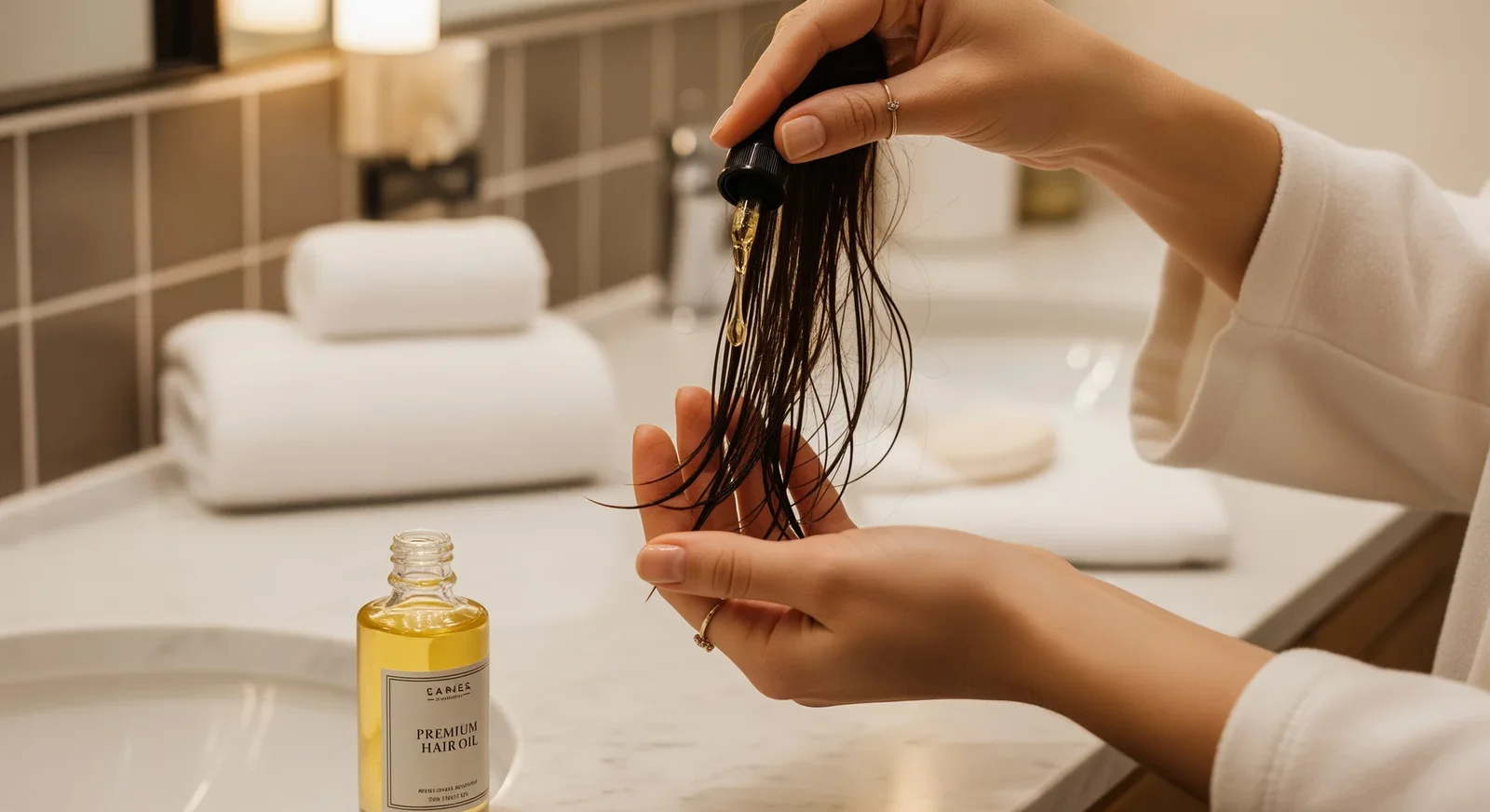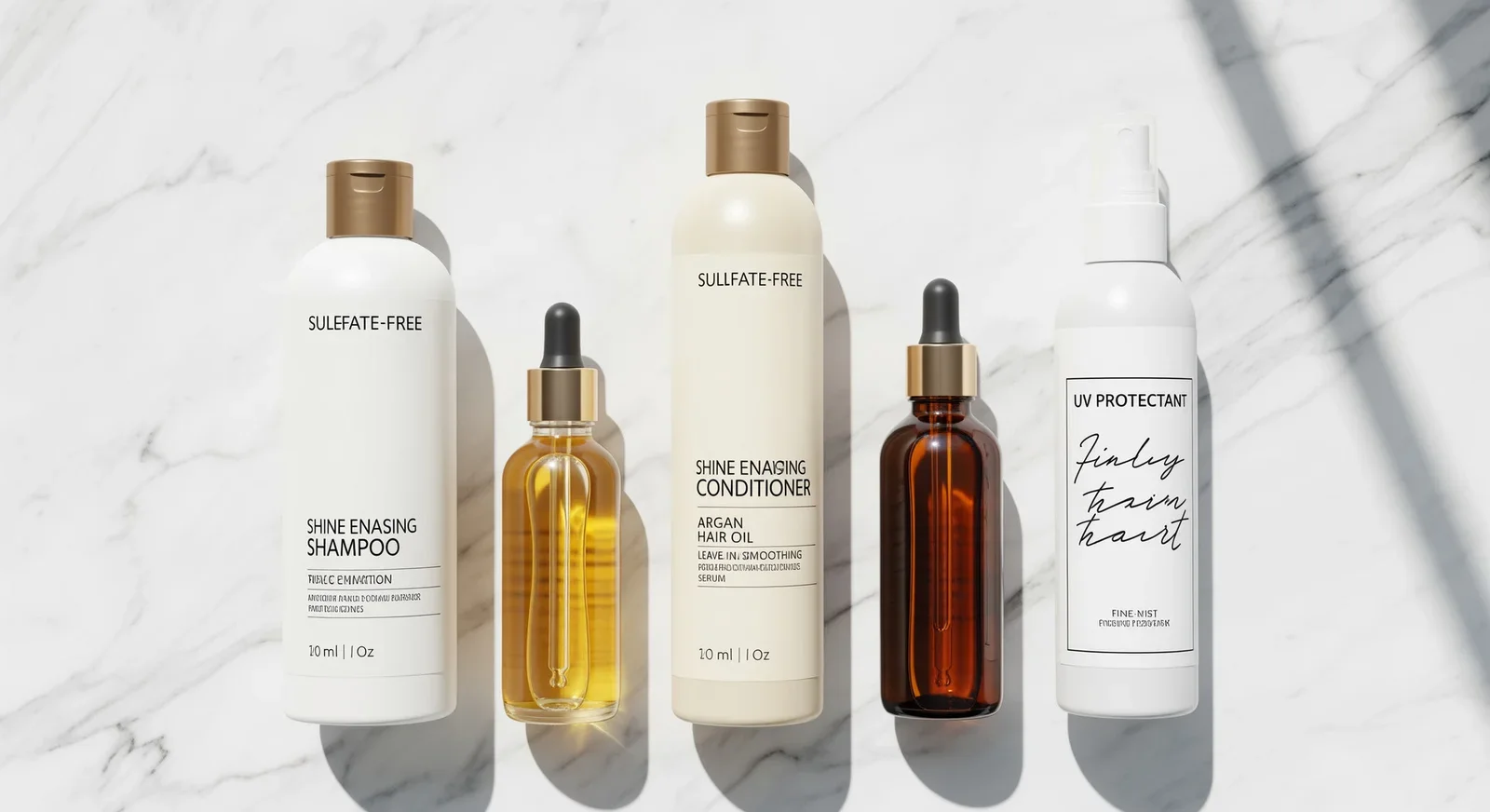How to Achieve the Hair Gloss Look
Getting that hair gloss look is about turning your hair into a smooth, mirror-like sheet that reflects light. It isn’t just surface shine; it’s hair that looks healthy, lively, and polished. This guide explains what hair gloss is, how it works, the best salon and at-home options, and how to keep that bright, glassy finish.
What Is the Hair Gloss Look?
The hair gloss look means hair with strong, glassy shine, a smooth feel, and rich colour. It’s that healthy, reflective glow you often see in photos and on red carpets. This isn’t only “shiny” hair; it’s a clean, even reflection that signals strong, well-kept hair.
People aim for this result because light-reflective hair looks younger, healthier, and more lively. It shows the cuticle is smooth and the strands are well fed-key signs of truly healthy hair.
How Does Glossy Hair Differ from Shiny or Oily Hair?
All glossy hair is shiny, but not all shiny hair is glossy. Shine quality matters. When light hits hair, it reflects in two ways: specular and diffuse. Specular reflection is neat and even, creating that mirror effect. Diffuse reflection scatters light, making hair look dull. Smooth, sealed cuticles lead to specular reflection and a silky gloss. Raised, rough cuticles scatter light and reduce shine.
Oily hair may look “shiny,” but that sheen comes from extra sebum or product film. That film can blur the surface and absorb light instead of bouncing it back. Glossy hair looks clean and bright, not greasy.
How Does Hair Gloss Work?
Hair gloss works by sealing the cuticle to make a smoother surface that reflects light better-like buffing a dull surface. This process boosts shine and also helps hair look and feel healthier by holding moisture in and shielding the hair fibre.
The idea is to get more even, mirror-like reflection. Gloss formulas fill porous spots along the shaft, creating a uniform surface. Less scatter, more clean bounce-hello glow.
What Is a Hair Gloss Treatment?
A hair gloss is a shine-boosting, conditioning treatment that makes hair look healthier and brighter. You can get it at a salon or use it at home. It’s especially good for colour-treated hair because it refreshes colour, slows fading, and makes hair feel silky. Clear versions are great for virgin hair too, adding shine and cutting frizz.
Unlike regular dye, gloss is usually semi-permanent. It may add a soft tint without changing your natural pigment. It often applies like a conditioner and sits for 5-10 minutes, making it a quick way to refresh your look.
How Do Hair Gloss Products Boost Shine?
Gloss products work in a few ways. First, they help the cuticle lie flat so light bounces off evenly. Second, many include conditioners that hydrate hair, making it softer and more flexible, which also helps light reflect.
Some add extra help for reflection. Oils like Marula and Camellia soften hair for a smoother surface. Glycolic acid, borrowed from skincare, can improve light bounce for high shine. By clearing buildup and smoothing damage, these products can turn dull hair into a bright, glossy finish.
Benefits of Achieving the Hair Gloss Look
Shiny hair looks great, but glossing also helps how your hair behaves. These treatments can make hair softer, easier to manage, and more protected day to day.
Improves Hair Health and Appearance
Glossing can quickly make hair look and feel better. By coating and smoothing the cuticle, hair looks brighter and healthier and feels softer. Many glosses skip harsh chemicals like ammonia and bleach, so they don’t weaken the hair. They can even help stressed or over-processed strands look livelier.
Healthier hair tends to be easier to handle. Smooth, hydrated strands tangle less and need less heat styling, which helps keep hair strong over time.
Protects Colour and Reduces Fading
For colour-treated hair, gloss acts like a clear topcoat. It helps lock in colour and keeps it bright longer, delaying another colour session. The coating helps keep colour molecules from washing out or fading from sun and pollution.
Tinted gloss can refresh tones, cancel brass, and add depth between appointments. You can keep your colour rich and true for longer while stretching time between dyes.
Smooths Frizz and Seals the Cuticle
Frizz comes from raised cuticles that let moisture in, causing swelling and flyaways. Glossing smooths and seals the cuticle, keeping excess moisture out and hair sleek. You get more shine and a lot less frizz.
This seal also helps guard against pollution, UV, and styling wear. For unruly hair, a gloss can give a smoothing effect similar to keratin-style treatments, but often lighter and without strong smells.
Types of Hair Gloss and Similar Treatments
Choosing hair treatments can be confusing, with terms like gloss, glaze, and dye used interchangeably. Knowing the differences helps you pick what fits your goals.
What’s the Difference Between Hair Gloss and Hair Glaze?
Both smooth the hair and boost shine, but they last and work differently. Gloss tends to condition more deeply and last longer-often up to four weeks-because it can reach the cuticle slightly for a bigger improvement.
Glaze is more short-lived, usually fading in one to two weeks. It’s a quick shine lift or short-term tone tweak. For ongoing upkeep and deeper benefits, gloss is usually the better pick.
| Feature | Hair Gloss | Hair Glaze |
|---|---|---|
| Longevity | About 3-4 weeks | About 1-2 weeks |
| Depth of care | Deeper conditioning | Surface refresh |
| Result | Stronger shine and smoother feel | Quick shine boost |
Hair Gloss vs. Hair Dye: Key Distinctions
Gloss is usually semi-permanent and adds shine and a soft tint without changing your natural pigment. Most formulas skip ammonia and bleach, so they’re gentler and mainly coat the cuticle for shine and tone.
Dye changes your colour by opening the cuticle and shifting pigment in the cortex, often with ammonia or bleach. That can stress hair with frequent use. Dye is about changing colour; gloss is about boosting, refreshing, and adding shine to what you already have.
In-Salon vs. At-Home Hair Glossing Treatments
Salon and at-home gloss both work well, but they suit different needs. In salons, stylists use pro systems and can custom mix tones that you can’t get off the shelf. They can check your hair and apply evenly for longer-lasting results.
At-home gloss is convenient and budget-friendly. Many options are easy to use with little to no mixing and can show results in under ten minutes. You may need to apply more often than salon gloss, but it’s great for upkeep between appointments. Brands like L’Oréal Paris offer complete at-home kits that are simple to use.
Who Should Consider a Hair Gloss?
Gloss works for many hair types and goals. If you want brighter shine, better feel, or longer-lasting colour, it can help. It’s a low-commitment option with big payoff.
Suitable Hair Types and Conditions
Gloss can help most people who want softer, shinier hair. It’s especially good for dry, damaged, or dull hair. If your hair feels rough or looks flat, a gloss can bring it back to life.
Clear gloss on virgin hair boosts shine, reduces frizz, and makes hair feel smooth without changing your natural colour. It’s a simple way to keep hair in good shape and get that bright finish.
Considerations for Colour-Treated Hair
For coloured hair, gloss is a go-to. It helps colour last, keeps it bright, and adds tone control between appointments. Tinted gloss can refresh a fading shade, cancel brass, or add warmth.
Because gloss is gentle and typically ammonia-free, it’s a safer way to keep your colour looking fresh, especially if your hair is already stressed from past treatments. It seals the cuticle to hold moisture and pigments in.
Gloss for Curly, Wavy, and Straight Hair
Gloss benefits all textures. On curls and waves, it can define shape, reduce frizz, and improve bounce. Many with type 3 curls report better definition and softer feel with at-home glossing.
On straight hair, gloss gives that sleek, reflective look and tames flyaways for a smooth finish. Whatever your texture, gloss can boost shine, smoothness, and overall hair feel.
Step-By-Step: Achieving the Hair Gloss Look at Home
You can get glossy hair at home with the right routine. Focus on clean hair, good conditioning, and a shine treatment applied the right way.
1. Shampoo with a Nourishing Cleanser
Start with a gentle wash. Dirt, product buildup, and extra oil block shine. Pick a shampoo that cleans without stripping. Nutritive Bain Satin Hydrating Shampoo for Dry Hair removes impurities and pollution while feeding hair from root to tip for a brighter look.
Do not over-wash, as that can remove needed oils. If you wash the night before glossing, keep hair free of styling products after washing. A little natural oil return can help the gloss grab onto the hair.
2. Use a Conditioner for Hydration and Shine
After shampoo, use a quality conditioner to smooth the cuticle and boost shine. Nutritive Lait Vital Conditioner, with lipids, iris root extract, and glucids, helps seal the fibre to lift shine while keeping a light feel.
Focus on mid-lengths and ends. Leave it on as directed and rinse well. This step helps detangle, hydrate, and prep hair so the gloss works better.
3. Apply a Gloss or Shine-Boosting Treatment
Now for the hero step. After washing and conditioning, apply your gloss or shine treatment. Follow the directions closely, as some go on wet hair after shampoo, and others go on dry hair. For example, Chroma Absolu Soin Acide Chroma Gloss is applied to wet hair after shampoo, then you use conditioner.
For systems like L’Oréal Paris EverPure Sulfate-Free Glossing System, you’ll use a shampoo, conditioner, and a glossing mask. Use the mask two to three times per week for best results. Coat every strand evenly for maximum shine.
4. Introduce Hair Oil to Your Routine
A good hair oil helps maintain shine and hair health. Oils smooth the surface so hair reflects more light. Elixir Ultime Original Hair Oil suits all hair types and includes Marula and Camellia oils to nourish and strengthen. It also offers heat protection.
Use a small amount on damp or dry hair, focusing on mid-lengths and ends. This locks in moisture, adds shine, and controls frizz throughout the day.
5. Minimise Heat Styling and Protect from Damage
Too much heat dulls hair and causes breakage and frizz. Limit hot tools when you can. When you do use them, always apply a heat protectant, like L’Oréal Paris Elvive Dream Lengths Heat Slayer Leave-In, to shield strands and keep them soft. This helps keep your shine.
Rinse hair with cooler water, since hot water can roughen the cuticle. Air-dry when possible. If you blow-dry, a pro blowout can smooth the cuticle for stronger, brighter shine that lasts.
6. Focus on Scalp Care for Lasting Results
Your scalp has a big role in how your hair looks and grows. A balanced, hydrated scalp supports glossy, soft, healthy hair.
Use scalp care products like Nutritive Scalp Food Hydrating Scalp Serum to feed the roots. These serums add quick moisture to dry scalps and set the stage for better growth and shinier hair.
7. Pay Special Attention to Hair Ends
Dry, damaged ends dull your overall look and lead to splits and breakage. Show extra care to your ends to keep your hair glossy from root to tip.
Try a targeted serum like Nutritive Fibre Food Hair Serum for Dry Ends to add moisture and strength to brittle tips. Regular trims also remove splits and keep your hair looking clean and bright.
Recommended Hair Gloss Products and Ingredients
Picking the right products and knowing the standout ingredients will help you get and keep that shine.
Leading Salon and At-Home Gloss Options
Salons offer advanced glossing. Kérastase has Chroma Absolu Soin Acide Chroma Gloss with Lactic Acid and Centella Asiatica for sensitised, colour-treated hair. Franck Provost salons suggest semi-gloss shades like L’Oréal DIA Light for up to 6 weeks of shine, or a clear gloss using the same tech for extra sheen without changing colour.
At home, L’Oréal Paris offers complete lines like EverPure Sulfate-Free Glossing and Elvive Glycolic + Gloss. L’Oréal Paris Le Color Gloss One Step In-Shower Toning Gloss is easy to use, vegan, keratin-safe, and free from ammonia, parabens, phthalates, sulfates, and mineral oil, with Coconut Oil for care. Other solid picks include Kristin Ess Gloss (the Copper Penny shade went viral) and dpHUE Gloss+, which doubles as a deep conditioner and comes in clear and many shades.
Key Ingredients for Glossy Hair
Look for these shine and care all-stars:
Marula Oil: Softens hair and creates a smoother surface for better reflection.
Camellia Oil: Feeds hair and boosts shine and softness.
Lactic Acid: Helps resurface the cuticle for smoothness and light bounce.
Centella Asiatica: Supports cuticle care and scalp health, which helps shine.
Glycolic Acid: Improves light reflection for high-gloss results, seen in Elvive Glycolic + Gloss.
Lipids, Iris Root Extract, and Glucids: In conditioners to seal the fibre, lift shine, and strengthen.
Coconut Oil: Adds care and deep moisture, helping hair look bright and smooth.
What to Look for When Buying a Hair Gloss
Keep these points in mind to pick the right product:
Clear vs. Tinted: Choose clear for shine only. Pick tinted to refresh or tweak tone. For blondes, clear is often a safe bet.
Ammonia-Free Formulas: Most glosses skip ammonia. Check the label to avoid harsh ingredients.
Conditioning Benefits: Many glosses hydrate and cut frizz, so hair feels as good as it looks.
Ease of Application: At-home users may want simple, no-mix options.
Longevity: Many last 4-6 weeks, but some are shorter. Pick based on how often you want to reapply.
Specific Hair Needs: Look for formulas made for coloured, damaged, or frizzy hair if that fits you.
How to Maintain the Glossy Look
Keeping hair glossy takes steady care. With the right habits and products, you can hold onto that shine longer.
Routine Maintenance and Frequency
Consistency matters. Salon semi-permanent gloss usually lasts about four weeks, so a monthly touch-up works for many people. The fade is gradual, so hair won’t suddenly look dull.
At-home gloss may need more frequent use, sometimes two to three times a week, especially if it’s a lighter formula or a glossing mask. Watch your hair: if shine drops or frizz rises, it’s time to reapply.
Tips to Extend Results Between Treatments
Use these tips to stretch your results:
Use Colour-Safe Products: With tinted gloss, pair with sulfate-free, colour-safe shampoo and conditioner like L’Oréal Paris EverPure.
Wash Less Often: Fewer washes help gloss and colour last. Use dry shampoo between washes.
Cooler Rinses: Rinse with cooler water to help keep the cuticle smooth.
Limit Heat: Heat fades gloss and dries hair. Use hot tools less, and always add heat protectant if you do.
UV Protection: Sun fades colour and shine. Use UV filters or wear a hat outside.
Avoid Chlorine: Protect hair before swimming by wetting it and applying leave-in conditioner, and rinse right after.
Products for Ongoing Shine and Protection
Add these to your routine to keep shine going:
Leave-in Serums and Oils: L’Oréal Paris Elvive Glycolic + Gloss High Shine Leave-in Serum or Elixir Ultime Original Hair Oil add daily shine and smooth the cuticle.
Hair Masks: Weekly masks like Kérastase Ultime Hair Mask help restore softness and shine. Apply to mid-lengths and ends for 5-10 minutes.
Shine Sprays: Kérastase Elixir Ultimate L’Huile Légère Smoothing Mist or L’Oréal Professionnel RingLight Spray add instant glow and hide dry ends.
Heat Protectants: Always apply before hot tools to prevent dullness and frizz.
Risks and Considerations of Hair Gloss Treatments
Hair gloss is generally safe and helpful, but it’s smart to know possible downsides so you can avoid them.
Is Hair Gloss Safe for All Hair Types?
Gloss is usually gentle and safe for most hair types. Many formulas skip harsh chemicals, and the smoothing effect can even help damaged hair look better by adding a protective layer.
Fine, thick, straight, wavy, and curly hair can all benefit. Clear gloss works well on virgin hair too. If you have scalp issues or very damaged hair, check with a hairdresser or dermatologist before you try it.
Potential Side Effects and How to Avoid Them
Gloss is low-risk, but keep these points in mind:
Temporary Colour Shifts (with tinted gloss): Pick a shade close to your current tone. If unsure, choose clear for shine without colour risk.
Product Buildup: Using too much too often can weigh hair down. Follow usage directions and rinse well.
Allergic Reactions: If you have sensitive skin or allergies, do a patch test first.
Expectations: Gloss refines and refreshes. It won’t give a dramatic colour change or rebuild bonds.
Read instructions, pick shades wisely, and ask a pro if you’re unsure which product suits you.
Professional Advice: Salon vs. DIY Glossing
Choosing salon or DIY depends on budget, comfort with applying products, and the result you want. Both can work well if used the right way.
When to Visit a Professional Stylist
Book a salon gloss if:
It’s your first gloss or you want a bigger tone shift: A stylist can guide you, pick the right shade, and apply evenly.
Your colour is complex: For highlights, balayage, or tone correction, a pro can mix custom shades for precise results.
Your hair is damaged or sensitised: A stylist can choose a safe, effective gloss that helps without adding stress.
You want longer wear: Pro formulas often last longer and give stronger shine.
You want the experience: A salon visit often includes a relaxing wash and a pro blowout for that glassy finish.
Complimentary consultation: Many Kérastase salons offer free hair checks and product advice.
How to Choose the Right Salon Treatment
Keep these points in mind:
Consultation: Talk through your goals, hair state, and concerns.
Type of Gloss: Ask about clear vs. coloured options.
Custom Mix: Good stylists can adjust formulas to target your needs. Kérastase Fusio-Dose, for example, can be mixed to target dullness with a shine booster.
Brand and Ingredients: Ask what they use and why. Pro products often give better results.
Maintenance Tips: Get advice on at-home care and how often to come back.
Cost: Clarify pricing. A quick sink gloss may be about $30 AUD as an add-on, while deeper treatments cost more.
At-home gloss is great for upkeep, but pro gloss gives expertise, custom shades, and often longer wear-worth it if you want a bigger boost.
Frequently Asked Questions on Achieving the Hair Gloss Look
It’s normal to have questions when trying a new hair treatment. Here are clear answers to common ones about hair gloss.
Does Gloss Treatment Change Hair Colour?
It depends on the type you use: clear or tinted.
Clear Gloss: Adds shine and smoothness without any colour. It coats the cuticle so hair reflects more light.
Tinted Gloss: Adds a soft wash of colour without changing your natural pigment structure. Great for brightening your tone, fixing brass, or adding warmth. Think of it as a gentle colour booster, not a full dye.
Clear won’t change colour; tinted adds a hint of tone, so choose your shade with care.
Can Hair Gloss Repair Damage?
Gloss doesn’t rebuild hair bonds like some protein treatments, but it can make damaged hair look and feel much better:
Smooths the Cuticle: Seals rough spots for softer feel, more shine, and less frizz.
Adds a Shield: The coating helps protect from daily wear and tear.
Hydrates: Many formulas add moisture so hair is less brittle and more flexible.
It won’t fix severe damage, but it’s a gentle way to improve look and feel between bigger treatments.
How Can I Make the Gloss Last Longer?
Longevity depends on porosity, wash habits, and care. Try these tips:
Use Sulfate-Free, Colour-Safe Products: These protect both clear and tinted gloss.
Wash Less Often: Stretch days between washes; use dry shampoo in between.
Cooler Water: Rinse with lukewarm or cool water to help keep the cuticle flat.
Limit Heat: Use hot tools less and always add heat protectant.
Shield from Sun and Chlorine: Wear a hat and use leave-in conditioner before swimming.
Use Leave-ins and Oils: These keep hair smooth and reflective longer.
Regular Touch-Ups: Reapply at-home gloss as directed (some need 2-3 times a week). Follow your stylist’s schedule for salon gloss (often every 4-6 weeks).
With these habits, your gloss will stay bright and your hair will look healthy for longer.
Do you live in Sydney?
Get the perfect look at our salon – schedule your appointment now!
Our Services
Check Out Our Instagram
Check out our instagram
Check out our instagram and see our latest posts!
Check out our facebook
Check out our facebook and see our latest
posts!













